
In recorded history, the planet Jupiter has experienced impact events and has been probed and photographed by several spacecraft.

In recorded history, the planet Jupiter has experienced impact events and has been probed and photographed by several spacecraft.
| Event | Date (UTC) | Rough original size (meters) | Latitude (°) | Longitude (°) | Discoverer(s) |
|---|---|---|---|---|---|
| Aug 2023 event [2] | 2023/08/28 16:45 | ? | ? | ? | ? |
| Oct 2021 event [3] [4] | 2021/10/15 13:24 | ? | +20 | 201 | Ko Arimatsu |
| Sep 2021 event [5] | 2021/09/13 22:39:30 | ? | −5.5 | 105.7 | José Luis Pereira |
| Apr 2020 event [6] | 2020/04/10 | 1-4 | ? | ? | Juno team |
| Aug 2019 event [7] | 2019/08/07 04:07 | ? | ? | ? | Ethan Chappel |
| May 2017 event [8] [9] | 2017/05/26 19:25 | 12 | +51 | ? | Sauveur Pedranghelu |
| Mar 2016 event [8] [10] | 2016/03/17 00:18:33 | 15 | ? | ? | John McKeon |
| Sep 2012 event [8] [11] | 2012/09/10 11:35:00 | 30 | +2 | 345 | Dan Peterson |
| Aug 2010 event [8] [12] | 2010/08/20 18:22:12 | 10 | +11 | ? | Masayuki Tachikawa Aoki Kazuo |
| Jun 2010 Jupiter impact event [13] | 2010/06/03 20:31:20 | 13 | ? | ? | Anthony Wesley |
| Jul 2009 Jupiter impact event [14] | 2009/07/19 13:30 | 200–500 | −57 | 55 | Anthony Wesley |
| Jul 1994 Comet Shoemaker–Levy 9 [15] | 1994/07/16 20:13:16 – 1994/07/22 08:06:16 | 1800 | varies for each fragment | varies for each fragment | Carolyn Shoemaker Eugene Shoemaker David Levy |
| Mar 1979 event [16] | 1979/03/05 17:45:24 | ? | ? | ? | Voyager team |
Comet Shoemaker–Levy 9 broke apart in July 1992 and collided with Jupiter in July 1994, providing the first direct observation of an extraterrestrial collision of Solar System objects. This generated a large amount of coverage in the popular media, and the comet was closely observed by astronomers worldwide. The collision provided new information about Jupiter and highlighted its possible role in reducing space debris in the inner Solar System.
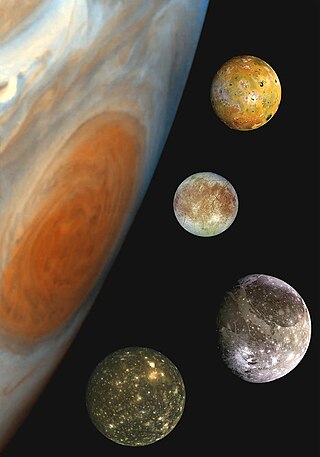
The Galilean moons, or Galilean satellites, are the four largest moons of Jupiter: Io, Europa, Ganymede, and Callisto. They are the most readily visible Solar System objects after the unaided visible Saturn, the dimmest of the classical planets, allowing observation with common binoculars, even under night sky conditions of high light pollution. The invention of the telescope enabled the discovery of the moons in 1610. Through this, they became the first Solar System objects discovered since humans have started tracking the classical planets, and the first objects to be found to orbit any planet beyond Earth.

Jupiter is the fifth planet from the Sun and the largest in the Solar System. It is a gas giant with a mass more than two and a half times that of all the other planets in the Solar System combined, and slightly less than one one-thousandth the mass of the Sun. Jupiter orbits the Sun at a distance of 5.20 AU (778.5 Gm) with an orbital period of 11.86 years. Jupiter is the third brightest natural object in the Earth's night sky after the Moon and Venus, and it has been observed since prehistoric times. It was named after Jupiter, the chief deity of ancient Roman religion.

Europa, or Jupiter II, is the smallest of the four Galilean moons orbiting Jupiter, and the sixth-closest to the planet of all the 95 known moons of Jupiter. It is also the sixth-largest moon in the Solar System. Europa was discovered independently by Simon Marius and Galileo Galilei and was named after Europa, the Phoenician mother of King Minos of Crete and lover of Zeus.

Uranus is the seventh planet from the Sun. It is a gaseous cyan-coloured ice giant. Most of the planet is made of water, ammonia, and methane in a supercritical phase of matter, which in astronomy is called 'ice' or volatiles. The planet's atmosphere has a complex layered cloud structure and has the lowest minimum temperature of 49 K out of all the Solar System's planets. It has a marked axial tilt of 82.23° with a retrograde rotation period of 17 hours and 14 minutes. This means that in an 84-Earth-year orbital period around the Sun, its poles get around 42 years of continuous sunlight, followed by 42 years of continuous darkness.
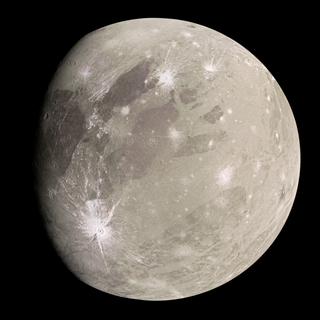
Ganymede, or Jupiter III, is the largest and most massive natural satellite of Jupiter as well as the largest in the Solar System, being a planetary-mass moon. It is the largest Solar System object without a substantial atmosphere, despite being the only moon in the Solar System with a substantial magnetic field. Like Titan, Saturn's largest moon, it is larger than the planet Mercury, but has somewhat less surface gravity than Mercury, Io, or the Moon due to its lower density compared to the three.

The Great Red Spot is a persistent high-pressure region in the atmosphere of Jupiter, producing an anticyclonic storm that is the largest in the Solar System. It is the most recognizable feature on Jupiter, owing to its red-orange color whose origin is still unknown. Located 22 degrees south of Jupiter's equator, it produces wind-speeds up to 432 km/h (268 mph). Observations from 1665 to 1713 are believed to be of the same storm; if this is correct, it has existed for at least 359 years. It was next observed in September 1831, with 60 recorded observations between then and 1878, when continuous observations began.

There are 95 moons of Jupiter with confirmed orbits as of 5 February 2024. This number does not include a number of meter-sized moonlets thought to be shed from the inner moons, nor hundreds of possible kilometer-sized outer irregular moons that were only briefly captured by telescopes. All together, Jupiter's moons form a satellite system called the Jovian system. The most massive of the moons are the four Galilean moons: Io, Europa, Ganymede, and Callisto, which were independently discovered in 1610 by Galileo Galilei and Simon Marius and were the first objects found to orbit a body that was neither Earth nor the Sun. Much more recently, beginning in 1892, dozens of far smaller Jovian moons have been detected and have received the names of lovers or daughters of the Roman god Jupiter or his Greek equivalent Zeus. The Galilean moons are by far the largest and most massive objects to orbit Jupiter, with the remaining 91 known moons and the rings together composing just 0.003% of the total orbiting mass.
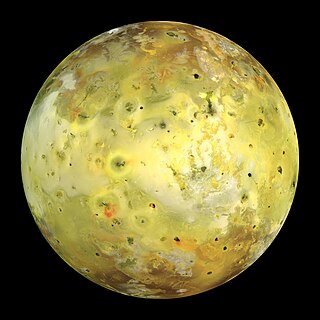
Io, or Jupiter I, is the innermost and third-largest of the four Galilean moons of the planet Jupiter. Slightly larger than Earth's moon, Io is the fourth-largest moon in the Solar System, has the highest density of any moon, the strongest surface gravity of any moon, and the lowest amount of water of any known astronomical object in the Solar System. It was discovered in 1610 by Galileo Galilei and was named after the mythological character Io, a priestess of Hera who became one of Zeus's lovers.

XO-1b is an extrasolar planet approximately 536 light-years away from Earth.
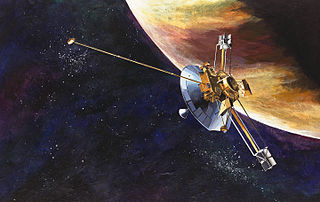
The exploration of Jupiter has been conducted via close observations by automated spacecraft. It began with the arrival of Pioneer 10 into the Jovian system in 1973, and, as of 2023, has continued with eight further spacecraft missions in the vicinity of Jupiter. All of these missions were undertaken by the National Aeronautics and Space Administration (NASA), and all but two were flybys taking detailed observations without landing or entering orbit. These probes make Jupiter the most visited of the Solar System's outer planets as all missions to the outer Solar System have used Jupiter flybys. On 5 July 2016, spacecraft Juno arrived and entered the planet's orbit—the second craft ever to do so. Sending a craft to Jupiter is difficult, mostly due to large fuel requirements and the effects of the planet's harsh radiation environment.
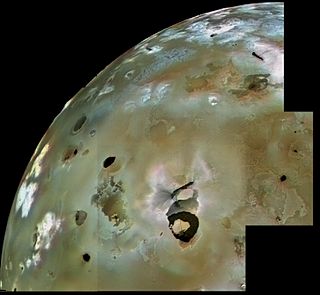
Loki Patera is the largest volcanic depression on Jupiter's moon Io, 202 kilometres (126 mi) in diameter. It contains an active lava lake, with an episodically overturning crust. The level of activity seen is similar to a superfast spreading mid-ocean ridge on Earth. Temperature measurements of thermal emission at Loki Patera taken by Voyager 1's Infrared Interferometer Spectrometer and Radiometer (IRIS) instrument were consistent with sulfur volcanism.

The 2009 Jupiter impact event, occasionally referred to as the Wesley impact, was a July 2009 impact event on Jupiter that caused a black spot in the planet's atmosphere. The impact area covered 190 million square kilometers, similar in area to the planet's Little Red Spot and approximately the size of the Pacific Ocean. The impactor is estimated to have been about 200 to 500 meters in diameter.

The exploration of Io, Jupiter's innermost Galilean and third-largest moon, began with its discovery in 1610 and continues today with Earth-based observations and visits by spacecraft to the Jupiter system. Italian astronomer Galileo Galilei was the first to record an observation of Io on January 8, 1610, though Simon Marius may have also observed Io at around the same time. During the 17th century, observations of Io and the other Galilean satellites helped with the measurement of longitude by map makers and surveyors, with validation of Kepler's Third Law of planetary motion, and with measurement of the speed of light. Based on ephemerides produced by astronomer Giovanni Cassini and others, Pierre-Simon Laplace created a mathematical theory to explain the resonant orbits of three of Jupiter's moons, Io, Europa, and Ganymede. This resonance was later found to have a profound effect on the geologies of these moons. Improved telescope technology in the late 19th and 20th centuries allowed astronomers to resolve large-scale surface features on Io as well as to estimate its diameter and mass.

The 2010 Jupiter impact event was a bolide impact event on Jupiter by an object estimated to be about 8–13 metres (26–43 ft) in diameter. The impactor may have been an asteroid, comet, centaur, extinct comet, or temporary satellite capture.

The atmosphere of Jupiter is the largest planetary atmosphere in the Solar System. It is mostly made of molecular hydrogen and helium in roughly solar proportions; other chemical compounds are present only in small amounts and include methane, ammonia, hydrogen sulfide, and water. Although water is thought to reside deep in the atmosphere, its directly measured concentration is very low. The nitrogen, sulfur, and noble gas abundances in Jupiter's atmosphere exceed solar values by a factor of about three.

Saturn's hexagon is a persistent approximately hexagonal cloud pattern around the north pole of the planet Saturn, located at about 78°N. The sides of the hexagon are about 14,500 km (9,000 mi) long, which is about 2,000 km (1,200 mi) longer than the diameter of Earth. The hexagon may be a bit more than 29,000 km (18,000 mi) wide, may be 300 km (190 mi) high, and may be a jet stream made of atmospheric gases moving at 320 km/h (200 mph). It rotates with a period of 10h 39m 24s, the same period as Saturn's radio emissions from its interior. The hexagon does not shift in longitude like other clouds in the visible atmosphere.

Amy Simon is an American planetary scientist at NASA's Goddard Space Flight Center, involved in several missions of the Solar System Exploration Program.

Alice is an ultraviolet imaging spectrometer, with one used on the New Horizons spacecraft, and another on the Rosetta spacecraft. Alice is a small telescope with a spectrograph and a special detector with 32 pixels each with 1024 spectral channels detecting ultraviolet light. The instrument has a mass of 4.4 kg and draws 4.4 watts of power. Its primary role is to determine the relative concentrations of various elements and isotopes in Pluto's atmosphere.
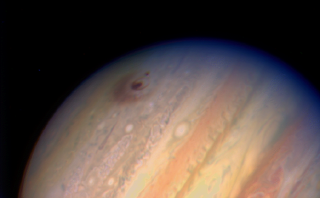
In modern times, numerous impact events on Jupiter have been observed, the most significant of which was the collision of Comet Shoemaker–Levy 9 in 1994. Jupiter is the most massive planet in the Solar System and thus has a vast sphere of gravitational influence, the region of space where an asteroid capture can take place under favorable conditions.